Table of Contents
Introduction
In today’s fast-paced product landscape, innovation isn’t just about launching new features — it’s about discovering the right ideas that deliver real customer value. For product teams, balancing vision, data, and feedback can be overwhelming. That’s where Jira Product Discovery comes in.
Developed by Atlassian, Jira Product Discovery bridges the gap between product ideation and software delivery. It enables teams to capture ideas, collaborate across departments, prioritize strategically, and link concepts directly to development execution in Jira Software.
This guide explores everything you need to know about Jira Product Discovery — its capabilities, benefits, setup process, and best practices — helping you master a smarter, more aligned approach to building products that customers love.
What Is Jira Product Discovery?
Jira Product Discovery is a dedicated product management tool from Atlassian designed to help teams collect, prioritize, and manage product ideas within a structured and transparent workspace.
Unlike spreadsheets or scattered feedback systems, Jira Product Discovery provides a unified environment where product managers can:
- Capture ideas from multiple sources (customers, teams, analytics).
- Evaluate them using data and customizable prioritization models.
- Align stakeholders around clear product goals.
- Connect discovery efforts to delivery tasks in Jira Software.
In short, it transforms raw ideas into actionable development initiatives — turning “what if” into “what’s next.”
Why Jira Product Discovery Matters
Traditional product management often struggles with fragmented communication. Product ideas might come from sales, marketing, or customer support, but without a central hub, they’re easily lost or duplicated. Jira Product Discovery solves this by centralizing idea management and ensuring that insights inform strategy and execution.
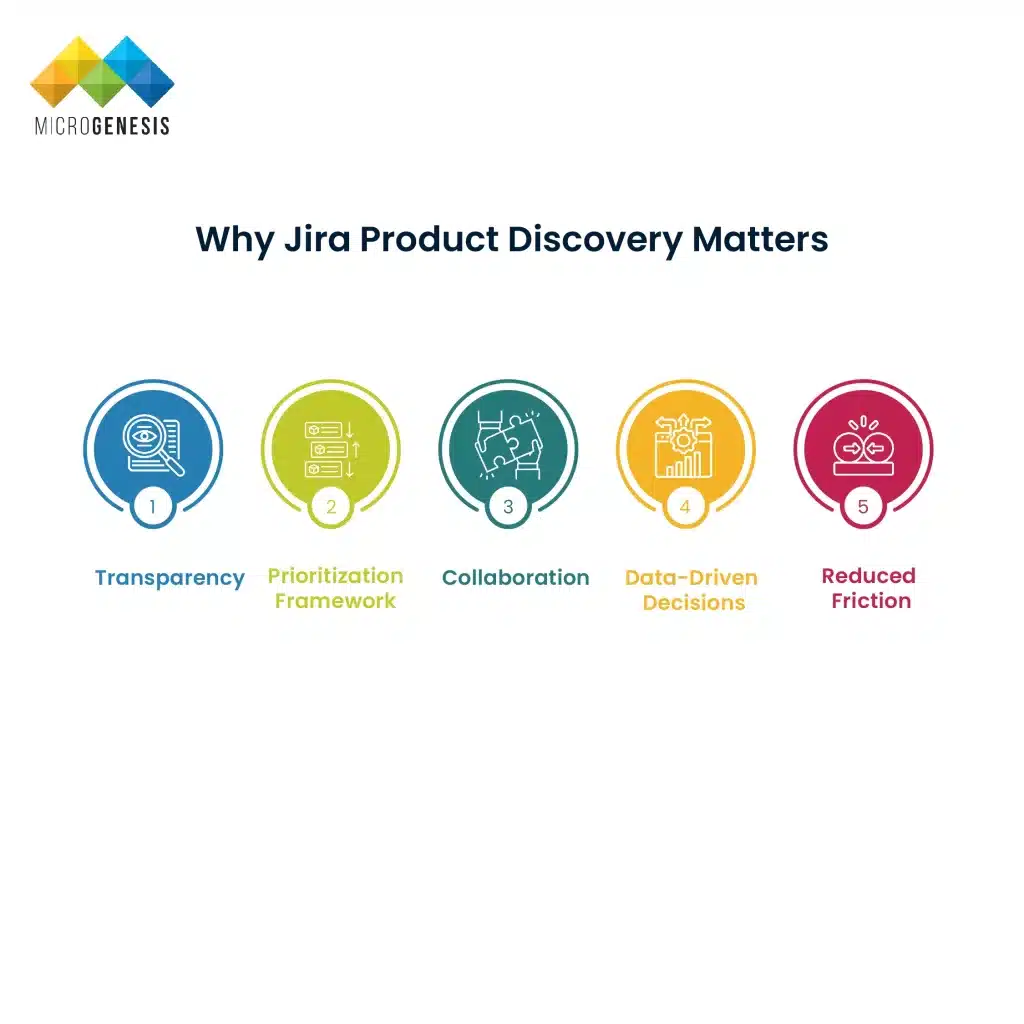
Key Benefits
- Transparency: Everyone in the organization can see which ideas are being considered and why.
- Prioritization Frameworks: Teams can rank ideas based on impact, effort, and strategic value.
- Collaboration: Integrates seamlessly with Jira Software, enabling cross-functional teamwork between product, engineering, and design.
- Data-Driven Decisions: Use insights and metrics to guide roadmap decisions.
- Reduced Friction: Eliminate disjointed tools and manual workflows.
Jira Product Discovery enables teams to think strategically, act collaboratively, and deliver confidently.
Core Features of Jira Product Discovery
Idea Capture and Management
At the heart of Jira Product Discovery is the ability to collect and organize ideas efficiently. Users can submit ideas directly or through integrations with forms, email, or Slack. Each idea can include context — user feedback, data points, or links — ensuring the rationale is clear.
Features:
- Custom fields for impact, confidence, and effort.
- Tags and components for organization.
- Voting or scoring for prioritization.
- Feedback tracking linked to customers or teams.
Views and Visualization
Visualization is key to understanding product direction. Jira Product Discovery offers multiple customizable views, such as:
- List view – for organized, tabular overviews.
- Board view – ideal for Kanban-style categorization.
- Matrix view – helps evaluate ideas by priority or complexity.
- Timeline view – visualizes ideas in a roadmap-like format.
Each view helps stakeholders understand priorities and dependencies clearly.
Prioritization Tools
Instead of subjective decision-making, Jira Product Discovery allows teams to use custom prioritization frameworks — such as RICE (Reach, Impact, Confidence, Effort), MoSCoW, or Value vs. Complexity.
By attaching numerical weights to each factor, teams can objectively evaluate which ideas matter most.
Collaboration and Insights
Cross-functional collaboration is effortless. Team members can comment on ideas, share updates, and link insights directly. Feedback from customers or support tickets can be tied to specific ideas, creating a traceable line from user need to implementation.
Integration with Jira Software
The platform’s biggest advantage is its tight integration with Jira Software. Once an idea moves to implementation, product managers can convert it into Jira issues or epics, maintaining traceability between product discovery and development.
Roadmapping and Delivery Tracking
Teams can turn approved ideas into actionable product roadmaps. By linking these roadmaps to delivery tickets in Jira Software, product and engineering teams stay aligned — ensuring strategy drives execution.
Customization and Scalability
Jira Product Discovery supports custom fields, labels, and templates, making it flexible for different team sizes and industries. Whether you’re a startup or an enterprise, it scales with your workflow complexity.
Getting Started with Jira Product Discovery
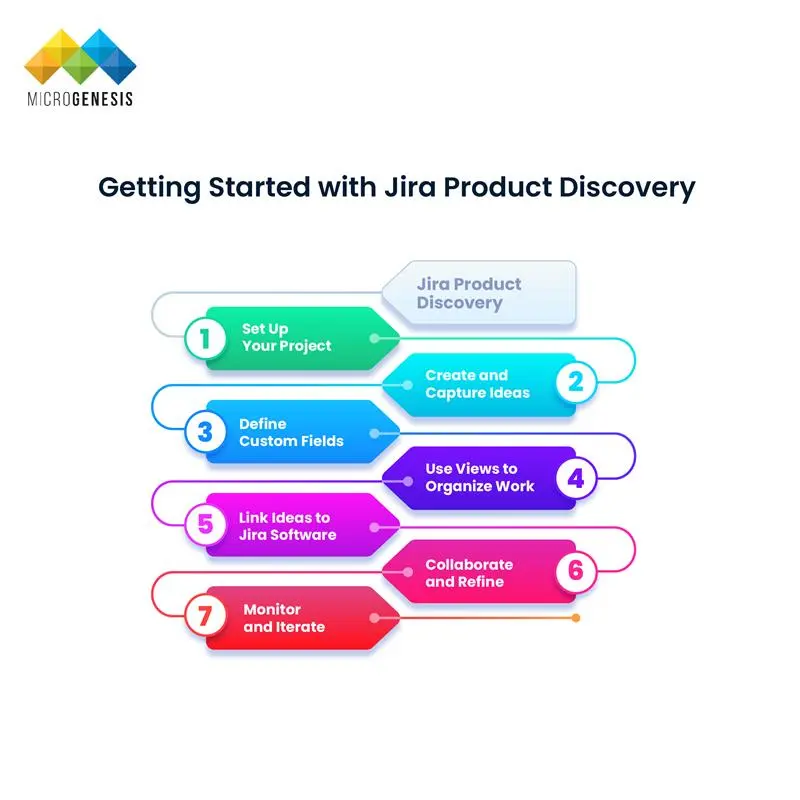
Step 1: Set Up Your Project
From Jira’s main dashboard, select Product Discovery and create a new project. You can name it after your product, initiative, or team.
Step 2: Create and Capture Ideas
Add your first idea manually or import from spreadsheets. Encourage your team to contribute through forms or integrations. Capture detailed context — problem statement, target users, value hypothesis, and data support.
Step 3: Define Custom Fields
Tailor your project with fields like:
- Impact
- Effort
- Confidence
- Strategic alignment
These fields serve as the foundation for prioritization.
Step 4: Use Views to Organize Work
Switch between views to filter and sort ideas. For example:
- Use Matrix view for effort vs. impact mapping.
- Use Timeline view for roadmap planning.
- Use Board view for status updates.
Step 5: Link Ideas to Jira Software
When ready, promote selected ideas into Jira issues or epics. This ensures traceability — everyone knows why something is being built and who requested it.
Step 6: Collaborate and Refine
Tag stakeholders, comment on progress, and document insights. Use embedded visuals, attachments, and links to maintain a rich knowledge base.
Step 7: Monitor and Iterate
Use reporting tools to assess which ideas deliver value. Refine your prioritization criteria based on outcomes and feedback.
Jira Product Discovery for Product Managers
For product managers, Jira Product Discovery serves as a strategic enabler that brings clarity and structure to the product development process. It consolidates scattered inputs from multiple teams, simplifies prioritization, and ensures that every decision aligns with business objectives and customer needs.
Benefits for Product Managers
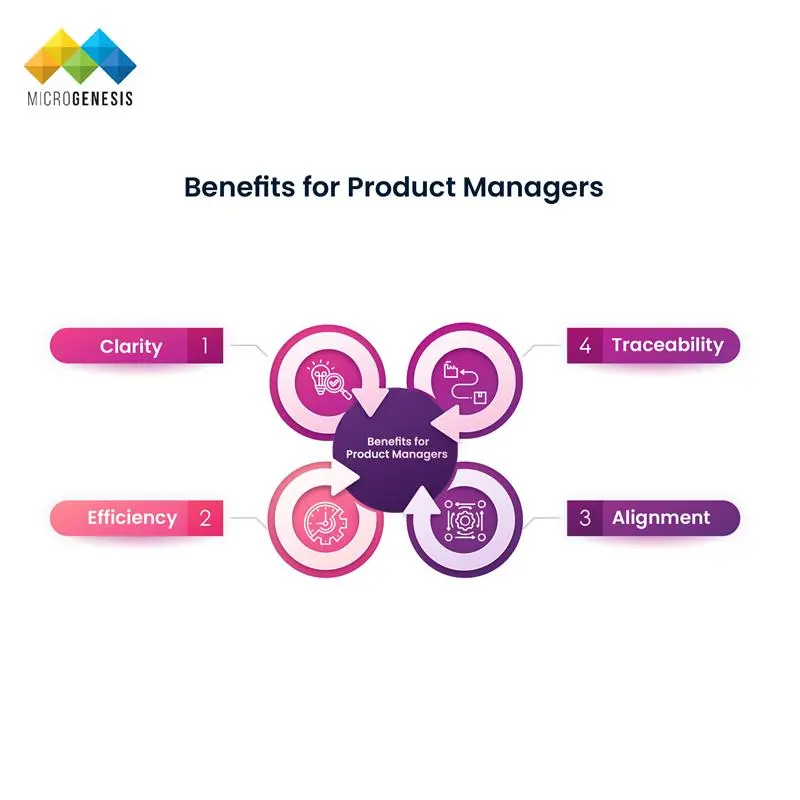
Clarity:
Jira Product Discovery provides a single, organized space where all product ideas and feedback are captured, tagged, and evaluated. This unified view eliminates duplication and confusion, allowing product managers to easily track progress and maintain transparency across teams.
Efficiency:
By streamlining idea evaluation and prioritization, the platform reduces manual overhead. Product managers can apply scoring frameworks such as RICE or MoSCoW to quickly assess the feasibility, impact, and effort required for each initiative — enabling faster, data-informed decision-making.
Alignment:
Jira Product Discovery bridges communication gaps between teams. Product managers can share roadmaps, discuss rationale, and align stakeholders around a shared vision. Integration with Jira Software ensures a seamless connection between discovery and delivery phases.
Traceability:
Every idea, once implemented, remains traceable back to its original context — whether it came from customer feedback, analytics, or internal discussions. This end-to-end visibility helps product managers demonstrate the business impact of their decisions and build stronger accountability within the organization.
In essence, Jira Product Discovery allows product managers to spend less time managing tools and more time driving strategic discovery, innovation, and value creation.
Jira Product Discovery for Teams
While Jira Product Discovery is a powerful tool for product managers, its true strength lies in how it enables cross-functional collaboration across the entire organization. Every department — from engineering to design, marketing, and support — plays a vital role in shaping product success, and this platform ensures their voices are heard and aligned.
Empowering Collaboration
Jira Product Discovery creates a shared workspace where teams can contribute ideas, provide feedback, and access the latest product priorities. This transparency helps eliminate silos, fostering a sense of collective ownership and accountability throughout the product lifecycle. By visualizing the reasoning behind each idea, teams gain a clearer understanding of why certain features are prioritized — strengthening motivation and trust.
Value Across Teams
- Engineering Teams: Gain early visibility into the product roadmap, allowing for better planning, feasibility assessments, and technical input before development begins.
- Design Teams: Participate in the discovery phase to ensure user experience considerations are integrated from the start.
- Sales and Support: Easily share customer insights and pain points, helping product managers validate ideas with real-world data.
- Executives and Leadership: Access concise, data-backed overviews of product initiatives to support informed decision-making.
Driving Alignment and Efficiency
By integrating with Jira Software, teams can seamlessly transition from idea to execution without losing context. Each idea’s journey — from concept to implementation — remains visible, ensuring alignment between discovery and delivery.
Ultimately, Jira Product Discovery transforms product development into a collaborative, transparent, and goal-driven process, empowering every team to contribute meaningfully to innovation and business growth.
Best Practices for Jira Product Discovery
Align Ideas with Strategy
Always connect ideas to your organization’s strategic themes or OKRs. This prevents feature creep and keeps innovation purposeful.
Prioritize Using Data
Combine qualitative insights with quantitative data. Use impact, confidence, and effort metrics to make informed trade-offs.
Encourage Team Participation
Make discovery inclusive. Enable all departments to suggest, discuss, and evaluate ideas.
Keep Views Consistent
Maintain standardized naming, tagging, and prioritization structures. This ensures consistency across teams and projects.
Integrate with Delivery
Always link approved ideas with Jira Software issues. It ensures visibility from ideation to implementation.
Iterate and Learn
Regularly review completed initiatives. Document learnings to refine future discovery cycles.
Common Challenges and How to Overcome Them
While Jira Product Discovery streamlines product management and collaboration, teams may encounter common challenges during adoption and day-to-day use. Understanding these challenges and implementing proactive solutions ensures that your discovery process remains efficient, transparent, and impactful.
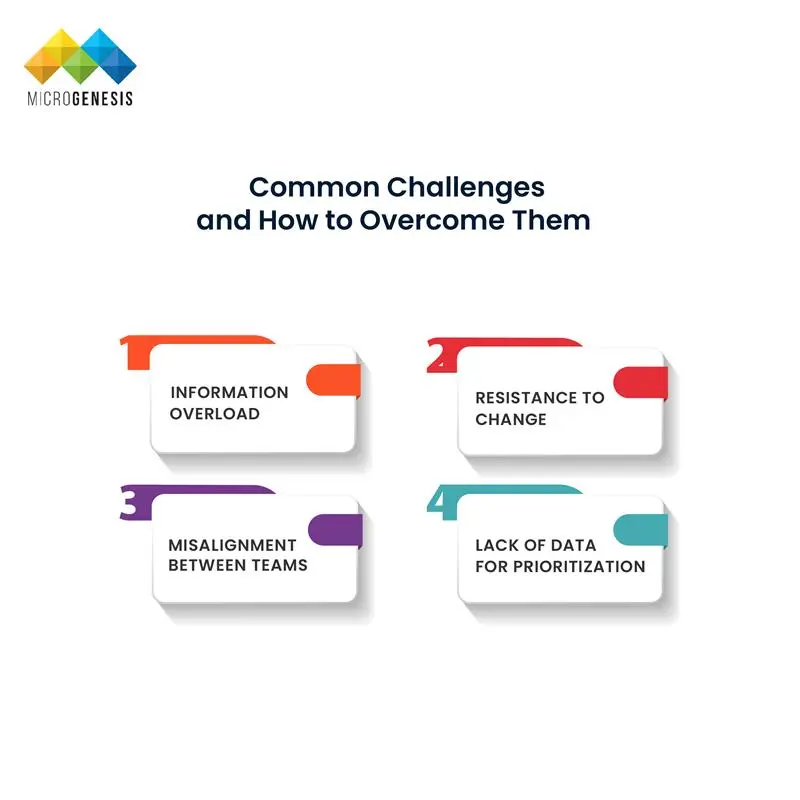
Challenge 1: Information Overload
Product teams often receive a high volume of ideas from multiple sources, including customers, sales, support, and internal brainstorming sessions. Without a structured approach, this abundance of information can become overwhelming, making it difficult to focus on the most strategic initiatives.
Solution:
Implement scoring and categorization frameworks early in the process. Use prioritization models like RICE, MoSCoW, or Value vs. Effort to objectively evaluate ideas. Tagging and grouping ideas by product area, customer segment, or business goal helps teams filter information and focus on the ideas that deliver the highest value.
Challenge 2: Misalignment Between Teams
Different departments may interpret priorities or product goals differently, which can lead to confusion, duplicated effort, and delayed decision-making. Misalignment reduces efficiency and weakens the overall strategy.
Solution:
Maintain shared views, roadmaps, and dashboards within Jira Product Discovery. Centralized visualizations — such as timelines, boards, and matrix views — act as a single source of truth for all stakeholders. Regular review meetings and collaborative planning sessions ensure that every team is aligned with the product vision and roadmap.
Challenge 3: Lack of Data for Prioritization
Decisions based purely on intuition or anecdotal feedback can lead to suboptimal outcomes. Without reliable data, product managers may struggle to justify prioritization choices or measure potential impact.
Solution:
Integrate analytics, surveys, and CRM data into your discovery process. Linking quantitative and qualitative insights to each idea allows teams to validate assumptions and make informed, evidence-based decisions. Over time, this builds a repository of knowledge that strengthens future prioritization efforts.
Challenge 4: Resistance to Change
Teams accustomed to legacy tools, spreadsheets, or informal workflows may resist adopting a new platform. Resistance can slow implementation and reduce the benefits of structured discovery processes.
Solution:
Adopt a gradual, phased approach to change management. Start with a small pilot project, demonstrate tangible value through early wins, and provide training sessions tailored to each team. Highlight success stories and integrate feedback to make the platform intuitive and relevant to daily workflows.
Use Cases of Jira Product Discovery
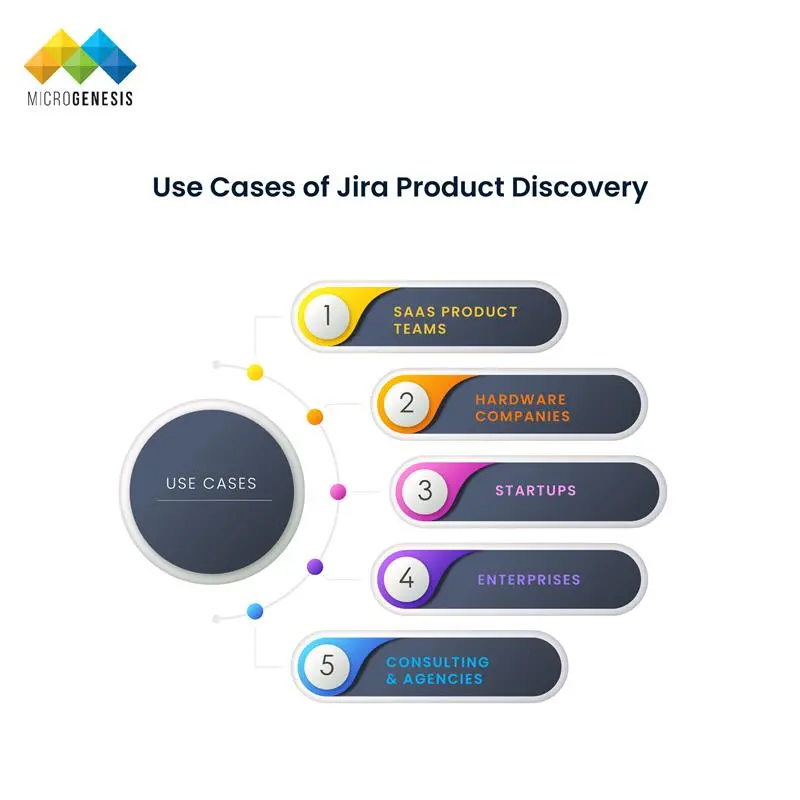
SaaS Product Teams
Use it to capture customer feedback, prioritize features, and align release cycles with user needs.
Hardware Companies
Track component improvements, design feedback, and cross-functional dependencies.
Startups
Manage idea backlogs and build product roadmaps without expensive, complex PM software.
Enterprises
Coordinate large-scale innovation pipelines across multiple departments and markets.
Consulting & Agencies
Collaborate with clients on discovery sessions, maintaining transparency and accountability.
Integration Ecosystem
Jira Product Discovery integrates with:
- Jira Software – for delivery management.
- Confluence – for documentation and collaboration.
- Trello – for lightweight task tracking.
- Slack and Microsoft Teams – for communication and idea capture.
- Google Workspace and Miro – for brainstorming and visualization.
Its API also supports custom integrations for analytics or CRM synchronization.
Measuring Success in Jira Product Discovery
Evaluating the effectiveness of your product discovery process is critical to ensuring that the time, effort, and resources invested in capturing and prioritizing ideas translate into tangible business outcomes. Jira Product Discovery provides the tools to track performance, but organizations must define clear key performance indicators (KPIs) to measure success effectively.
Key Metrics to Track
- Number of Ideas Submitted and Implemented
Track both the volume of ideas contributed by teams and the number that progress to execution. This metric indicates engagement levels across departments and the system’s effectiveness in capturing actionable insights. - Idea-to-Delivery Conversion Rate
Measure the percentage of ideas that move from discovery to implementation. A higher conversion rate reflects a focused prioritization process and alignment between product strategy and execution. - Time from Idea Submission to Release
Monitor the cycle time for ideas, from submission through validation and delivery. Shorter cycles indicate efficiency in decision-making and workflow management. - Stakeholder Satisfaction Scores
Gather feedback from internal teams, leadership, and customers to assess how well the discovery process meets their needs. High satisfaction scores suggest strong alignment and transparency. - Business Impact Metrics
Evaluate the tangible outcomes of implemented ideas, such as revenue growth, customer retention, product adoption rates, or user engagement. These metrics link discovery activities directly to business value.
By consistently tracking these KPIs, organizations can quantify the impact of structured product discovery, identify areas for improvement, and ensure that product decisions are both strategic and results-driven.
The Future of Jira Product Discovery
The evolution of Jira Product Discovery reflects broader trends in product management and innovation, emphasizing collaboration, intelligence, and data-driven decision-making.
Emerging Features and Capabilities
- AI-Assisted Idea Organization
Artificial intelligence is being integrated to help categorize, score, and suggest next steps for ideas, accelerating prioritization and reducing manual effort.
- Deeper Integration with Jira Cloud
Enhanced integration capabilities ensure seamless connections between discovery and development, allowing teams to track progress, dependencies, and outcomes in real time.
- Advanced Analytics and Reporting
New analytics tools provide insights into team performance, idea quality, and strategic alignment, enabling data-backed decisions and continuous process improvement.
Trends Shaping the Future
The future of product discovery will be collaborative, intelligent, and iterative:
- Teams will work across departments in real time, sharing insights and refining ideas collectively.
- Decision-making will be guided by predictive analytics, customer behavior data, and AI-driven insights.
- Organizations will increasingly link discovery directly to measurable business outcomes, ensuring every idea contributes to value creation.
In this evolving landscape, Jira Product Discovery empowers product teams to innovate faster, make smarter decisions, and deliver customer-centric products. By embracing emerging features and best practices, organizations can remain competitive, agile, and responsive to market needs.
Conclusion
Jira Product Discovery is transforming how product teams manage innovation. By bringing structure, transparency, and collaboration to the discovery process, it ensures that every decision aligns with customer needs and business strategy.
Whether you’re a startup or a global enterprise, Jira Product Discovery helps bridge the gap between idea and execution — turning creativity into measurable outcomes.
In the modern product landscape, success belongs to those who discover strategically, build collaboratively, and learn continuously. Jira Product Discovery provides the framework to do exactly that.
Bitbucket isn’t just about storing code
it’s about building smarter, faster, and more collaborative software delivery pipelines.
Our Blogs












